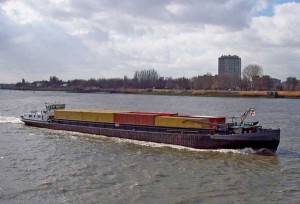09/08/2011 – The Second Line of Defense team visited the 11th USCG District in July 2011. The team included retired Rear Admiral Ed Gilbert who among other things was a former 11th USCG District commander. The current commander, Rear Admiral Joseph Castillo, provided a perspective of some of the key challenge posed by the size of the District as compared to his current capabilities.
The 11th USCG District is a very large area:
The Eleventh Coast Guard District encompasses the states of California, Arizona, Nevada, and Utah, the coastal and offshore waters out over more than a thousand miles from the California-Oregon border to the California-Mexico board, and the offshore waters of Mexico and Central America down to Ecuador. Coast Guard operational units are located throughout the state of California, with the Eleventh District and Pacific Area headquarters located on Coast Guard Island in Alameda, California along the east side of San Francisco Bay. (http://www.uscg.mil/d11/)

Rear Admiral Castillo highlighted a key reality for the USCG, which is oftentimes overlooked; the USCG has safety and security responsibilities for the inland waterways, a system which reaches significantly back from deepwater and port responsibilities, in addition to their more well known coastal and open ocean responsibilities. Indeed, one can conceive of ports as the hub of a wheel in which the spokes reach out into the ocean and back deep into the interior in certain areas.
Rear Admiral Castillo emphasized that with the very large area of offshore operations, it is critical to have enough assets to be physically present in the various diverse sub-regions throughout the AOR.
Rear Admiral Castillo: You need to have enough assets so that you are actually near or physically present in an area of interest. With the vast area to be covered, and the fact that ships move relatively slowly, a significant number of assets are needed to maintain this presence due to the simple reality of time-speed-distance..
And modern and capable ships, to me, are at the heart of persistent presence in terms of ability to execute the mission in the offshore area. For example, if you are pursuing a go fast vessel, you can have an MPA (Maritime Patrol Aircraft) tracking them. That is helpful, but I will need a ship partner with the MPA that is able to intercept, stop and board that ship to fully execute the law enforcement mission.
What I need is a persistent presence that can not only survey the area and identify the traffic in that area, but also be able to sort and target from among that traffic to identify those threats or challenges that are of interest to us.
Given the reality of the time/speed/distance problem, I’m just not convinced that you can achieve mission effectiveness without having a large number of assets, or a smaller number of more capable assets, that you can put against the threat or mission. And until we figure out how it is that we can star trek transport things around, I’m still stuck with the physics of being able to get boots on target right now.
Will there be a way of delivering by aircraft, long distances at sea, to get somebody on the target of interest? That may be where we can go in the future as opposed to only vessels. Who knows?
What I know now is that I need to be able to operate in all weather conditions with significant sea states and for extended periods of time and over long distances, and be able to deliver helicopters and small boats to effect end game, be it in law enforcement, search and rescue, migrant interdiction or other missions. I need to be able to sort, and figure out whom it is that I need to target, and be able to get somebody on that vessel that can take law enforcement interdiction action, and bring it to a successful conclusion.
When it comes to offshore search and rescue, when there’s no Coast Guard vessel anywhere nearby, AMVER has been very successful and saved a number of lives. This is a voluntary merchant vessel tracking system operated by the Coast Guard where merchant ships share their transit plan and make themselves available to assist fellow mariners in distress in their vicinity. This partnership has been very helpful in identifying merchant vessels that can help out when we can’t get one of our own platforms there.
We’ve also developed many great partnerships with other countries in the search and rescue realm as well. But we don’t have the same number of search and rescue cases well off our shores, and deep down in the Eastern Pacific than we do in the counter drug arena.
In the Eleventh District, the counter drug mission is the primary driver of the need for more ships to be available to prosecute, to evaluate, and engage whatever targets of interest we find.
Another key challenge, which the Rear Admiral discussed, was managing the conveyer belt of goods coming into the United States.
 “Almost half of all US containerized cargo comes through the Port of Los Angeles/Long Beach.” -Rear Admiral Costillo (Credit: Bigstock)
“Almost half of all US containerized cargo comes through the Port of Los Angeles/Long Beach.” -Rear Admiral Costillo (Credit: Bigstock)
Rear Admiral Castillo: Almost half of all US containerized cargo comes through the Port of Los Angeles/Long Beach. And if something were to shut that port down, the remaining ports on the west coast would not be able to handle the volume that one port complex handles. We work very closely with all of our partners in LA/LB, and in all our ports, to ensure the safety, security and efficiency of the port complex.
And the process currently in place throughout the country requiring an Advance Notice of Arrival 96 hours prior to entering a U.S. port is critical to our efficient management of this “conveyer belt”.
You never know for certain what’s in a given container, and you’ve got to be able to reach back overseas, and make sure that they’ve got the security in place where that container’s first getting loaded on a vessel. To enhance the probability that a container will not be a Trojan Horse you need to work with foreign authorities to reduce the risk inherent in the conveyer belt of global trade.
With the establishment of international standards, being able to be confidently determine what’s getting loaded onto vessels in foreign ports, and securing the cargo that’s being brought into our port long before it gets here, that’s a big part of risk management and defense in depth.
(Our piece on budget gaps: https://www.sldinfo.com/looming-gaps-face-the-uscg-either-reduce-the-responsibilities-or-enhance-the-resources/; our piece on the economic impact of the USCG: https://www.sldinfo.com/the-economic-impact-of-the-uscg-an-interview-with-rear-admiral-lee/)
SLD: What is the impact of the shortfalls in numbers of platforms on your thinking about operations?
Rear Admiral Castillo: We can’t be everywhere for everybody all the time. We have some very capable assets, and some very capable people.
For a short period, we can apply a good number of resources at a specific problem when it happens. But the consequence is that we are not able to apply the resources we would want against our other mission requirements. The vast majority of our assets are multi-mission, but you can’t necessarily use those multi-mission capabilities if you are overwhelmed by resource needs for a certain situation or location.
We’re always ready to tackle something. We’re not always ready to do every single thing at the same time.
SLD: If USCG resources were cut an additional 30%, what would be the impact on operations?
Rear Admiral Castillo: I think that from a policy standpoint, we would become very “near border” centric. And because that would affect the capacity to handle, even for a short period of time, that significant event that happens close to home, you would not see a lot of Coast Guard units forward deployed, in my opinion. If you’re talking about the type of resourcing that you just said, 30 percent cut, I think we would become more of a coastal guard.
SLD: Could we go back to the inland waterways challenges and discuss that a bit further?
Rear Admiral Castillo: We used to have a much more active presence inland with Boating Safety Teams. The decision was made some time ago to take that funding that supported that, give that to the states, so the states, as partners, couldmanage that, and the Coast Guard would focus more on the coast, still retaining some responsibilities and authorities, and primarily using the Coast Guard Auxiliary (an organization of volunteers) inland.
I’ve got a situation now where we’re working with Utah. Utah’s giving us I think three Utah Department of Natural Resources boats for the Auxiliary to run because we’re running short on assets, and they are running short on people. They’ve got these boats that are sitting there. It’s a partnership made in heaven that they’re willing to provide these boats and maintain them, so the Auxiliary can operate them. But that doesn’t happen everywhere.
And the number of boaters on the inland ways and rivers is just phenomenal.

SLD: The impact of national and state budgetary cuts can create a perfect storm where safety and security can be seriously compromised. What are your thoughts on the challenge of managing with missing assets?
Rear Admiral Castillo: There was a case here in Alameda quite recently, and I think it made national news. There was a gentleman who committed suicide by drowning in sight of the shore. He stood for some period of time in chest deep water.
People on shore were watching this, and there were police and firefighters who came to the scene. Because of the budget cuts to them locally, they had discontinued their water-rescue training two years prior, and nobody was trained. And there was no equipment.
They didn’t have the requisite training, and the equipment to make their own people safe to go ahead and attempt a rescue under those circumstances. The particular location that he was in, when our boat had arrived, it couldn’t get anywhere near him. The water was too shallow.
A half-mile away was the closest that we could get.
And it really does help to point out that over time, many of the people that we work with have changes to their capabilities. And depending on what their particular budgetary situation is, they could reduce or drop the marine patrol; that’s often one of the first things that gets cut is the marine patrol when it comes to budget shortages. We work hard at the Sector level to be aware of capability changes such as this one.
Cases that we would otherwise be looking for them to respond to as partners would then come to us. And I believe it is the question of what other calls are coming at the same time, whether we can pick up that load because if you’ve got six calls at the same time, you can’t get to all of them because you only got two assets.
Something’s got to give.
SLD: Next to Search and Rescue, what do you consider to be the core USCG mission today?
Rear Admiral Castillo: My answer would be the Port Security challenge to manage and protect the Maritime Transportation System. It is the conveyor belt of the national and global economies, moving people, goods, and services around the globe, and is a core national security issue. We cannot live as a country just within our waters. There are tremendous national security implications to keeping the Maritime Transportation System running safely and efficiently.

